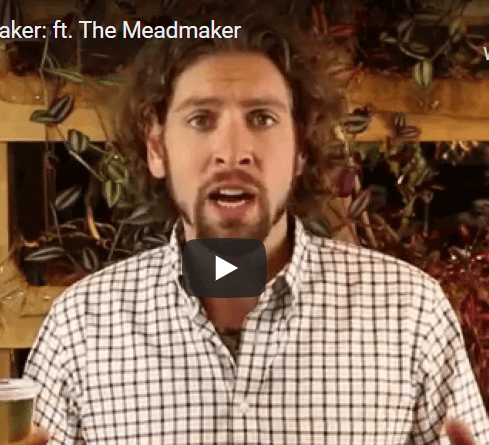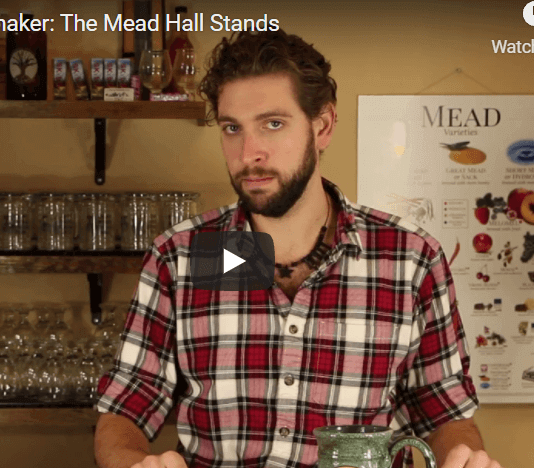In which Ricky the Meadmaker answers questions about nutrients, how long to wait before bottling, “housekeeping” needed for mead during and after fermentation, brewing with peaches, the effect of caffeine on yeast, and more!
It's Halloween this weekend, guys, and you'll never guess who I dressed up as. See if you can guess it. "This week's word is Colonel Bamford, who I served with in the Boer War." You get it? Jackass. He didn't even serve in the Boer war. He was press corps or something.
Welcome to Ask the Meadmaker, where I, Ricky the Meadmaker, answer your questions about mead making, mead drinking, mead brewing and really any question you're willing to send me.
The first question this week is a specific one. Adam wants to know when to add peaches to his fermenter. Now, the big question is primary or secondary? Does he mix them in with the honey at the beginning or does he let the fermentation go and then add the peaches? The answer is, you usually have more flavor with fruit if you add it in the secondary fermentation. But I didn't want to miss an opportunity to tell a story about my friend Steve from Basic Brewing Radio. Many, many, many years ago, Steve added peaches to a fermenter of beer, I believe, and went away on holiday. The problem was the fermenter he was using was not a bucket but a carboy. A glass carboy. And that peach mash kicked up the fermentation to such an extent that the peach goo got stuck in the neck of the carboy. The pressure built and built and built until the entire carboy blew up, covering not one, not two, not three, not four, but six surfaces in his living room with peaches and beer. So, whenever you add the peaches or any macerated fruit, please do it in a bucket so that we don't end up with an enormous bottle bomb.
I just need to acknowledge that this is Episode 73 of Ask the Meadmaker, which means that we're part of a twin primes set of episodes. And we're about to enter a pretty substantial twin prime gap. It's a year from now before we're going to have twin prime episodes again, not that this probably bothers any of you, but for some reason it bothers me.
Two more questions from our friend Li in Thailand. The first question is how much DAP or Fermaid K should be added to a 6-7 L batch of mead? These are both yeast nutrients and like with all nutrients, I would recommend one, experiment; two, look to the internet.
Li's next question is what kind of a timeframe would I be looking at before bottling? And the answer is, don't bottle while it's still fermenting. After that, pretty much any time is good.
The next question is a great question. It comes from Philip. He used a term that I don't think I'd heard before. He referred to "housekeeping" during fermentation, and potentially after fermentation as well. Things like pH adjustment and tannin additions and sulfiting to control for dissolved oxygen and things like that. And mostly, to be 100% honest, I do the vast majority of that work in my initial setup of my fermentations. The reason I used Wyeast nutrient blend versus some of the others is because of the minerality. It controls for pH during fermentation. I have monitored pH during active fermentation, but I've never really done anything about it. The way to figure out at home is: honey source, nutrients used, and yeast. All of these will affect how much work you have to do during and after fermentation.
Our last question this week comes from Chris, who unfortunately asked a question that has exactly two opposite answers. He wants to know what effect caffeine has on yeast. And the answer is, caffeine can increase the life expectancy of saccharomyces cerevisiae, yeast, by 25%. It can also kill yeast. How frustrating is that? But the same is true for humans. Caffeine has a potentially positive effect on our life expectancy, but enough of it will kill you very quickly from the inside out. So, the quantities of caffeine that you're talking about with teas, especially, and coffee, even putting powdered caffeine in it, please don't do that at home. You probably aren't going to kill your yeast, but you might.
Well, that's our last question this week, I just need to send it over to Ricky with our Word of the Week. Ricky.
Ha ha ha, I can do impressions too. "Hi, I'm Ricky the Meadmaker, and I can digest and metabolize alcohol using some sort of weird enzyme heretofore unknown to science." That was a terrible impression. You don't know most of those words. This week's word is achirality. Achirality means that a molecule does not have stereoisomers. This may seem overly technical, but it actually comes up an awful lot. When you talk to people about teas, and especially mate, people will tell you that mate, a type of tea, they're not Camellia sinensis, doesn't have caffeine, it has "mateine" in it. This is false. There is no such thing as mateine, if they're very advanced scientifically, they might tell you it's a stereoisomer of caffeine, very similar but not the same thing. Except that caffeine is achiral. It doesn't have stereoisomers, so when you're working with mate, or many other things that have things like caffeine, it's usually caffeine.
Achirality, our Word of the Week and the end of the show. Keep sending your questions and I'll get to them as soon as possible. Cheers.




